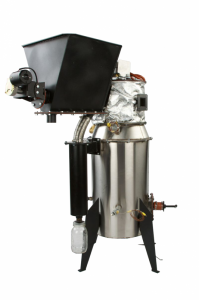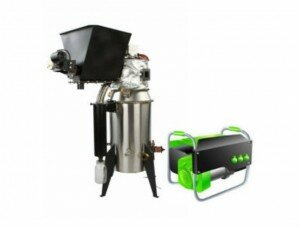Overview
The GEK TOTTI ( Gasifier Experimenter’s Kit, Tower of Total Thermal Integration ) is the gasifier system at the heart of the Power Pallet. This document will introduce the major subsystems of the GEK TOTTI gasifier in the sequence that starts from the feedstock hopper, proceeding through the drying bucket and reactor, and ends with the gas filter.
Notes about nomenclature and terms
The following are some terms you may come across in our product literature, videos, and in the course of speaking with our sales and support personnel which should be clarified to preclude confusion.
Feedstock, Fuel
The GEK TOTTI Gasifier onboard the Power Pallet is a refinery that takes crude biomass in the hopper and refines it into a cleanburning gaseous fuel for the engine, while producing charash as a waste product.
In engineering parlance, material fed into a refinery to drive a chemical process would be called feedstock , and the refined product going into the engine would be called fuel .
However, from the perspective of the user of the Power Pallet, the machine is fueled by biomass. Because of this, you may find the terms feedstock and fuel used interchangeably. For example, the paddle switch on top of the PyroReactor that regulates the feeding of biomass into the PyroReactor is called the fuel level switch (see Annotated Figure A), but in most of our literature, the biomass is referred to as feedstock.
Syngas, Wood gas, Producer gas
The terms syngas (short for synthesis gas ), wood gas , town gas and producer gas can be found in various literature on gasification. Each term has a few implications that differentiate it from the others:
● syngas (synthesis gas) refers to a gas mixture of CO (carbon monoxide) and H 2 (hydrogen) produced by reduction reactions where carbon is the reducing agent. Syngas is often used as a chemical precursor for the synthesis of other organic chemicals. Because of its use as a precursor for chemical synthesis in industry, this term usually implies a level
of purity and concentration not seen in gas produced by airaspirated biomass gasifiers.
● wood gas refers to gas produced by the gasification of wood. Wood gas is also rich in CO and H 2 , but may also contain tar gases, and may be diluted with nitrogen gas if the gasifier was aspirated with atmospheric air. However, since the Power Pallet does not necessarily gasify wood, and can be used to gasify various other feedstocks such as palm kernel shells, nut shells, and other biomass, we do not use this term in order to avoid implying the
need for wood.
● producer gas is a term generic enough to encompass wood gas, syngas, and other
produced gasses

The terms TOTTI , Pyrocoil , and PyroReactor
refer to parts of the engine exhaust waste heat recovery system. Some of these terms are legacy terms not relevant to the present machine, but still show up in discussions and literature, and bear clarification.
The term TOTTI in GEK TOTTI stands for “ Tower Of Total Thermal Integration .” The original GEK gasifier only incorporated one stage of waste heat recovery— recovering heat from producer gas to preheat incoming air. Later on, an addition to the gas circuit which we deemed the “Hot TOTTI” was developed to recover the heat from engine exhaust for pyrolysis and to enhance feedstock drying with more heat recovered from the producer gas. The combined GEK gasifier with the TOTTI heat recovery system was called the GEK TOTTI.
The TOTTI structure consisted of two major components, both of which recovered waste heat: the Pyrocoil , and the drying bucket . The Pyrocoil recovered heat from engine exhaust to create conditions for lower pyrolytic temperatures (400˚600˚) that result in primary tars, which are easier to crack. 1 The drying bucket was a wasteheatassisted drying vessel which enabled the gasifier to tolerate feedstock with higher moisture content. The Pyrocoil was inserted into the
reactor of the GEK, and received feedstock pushed in by the auger at the bottom of the drying bucket via an inlet on its side.
In the current version of the GEK TOTTI, the Pyrocoil has been integrated into the reactor to form a new and improved structure we call the PyroReactor . Because the Pyrocoil is no longer a distinct component, the TOTTI is no longer a distinct part of the gasifier. The name GEK TOTTI is now used as a brand.
Gasifier reactor
The reactor is the component of the gasifier that actually produces gas. When speaking of the structure circled in the image of the Power Pallet below, the terms gasifier and reactor are sometimes used interchangeably in our literature. In its entirety, the GEK TOTTI gasifier system
The Full Solution: the 20kw Power Pallet
The Power Pallet is a complete biomass power generation solution that converts dense biomass like wood chips and nut shells into electricity and heat. It is a compact, integrated system – from biomass in, to power out – delivered at the breakthrough price of $1-$2/watt.
The Power Pallet is comprised of the GEK Hot TOTTI multi-stage gasifier, spark fired industrial engine, generator head, and electronic controller. The system automatically adjusts syngas/air mixture via a wide band Bosch oxygen sensor, shakes the grate when needed, and removes ash via a mechanical auger. The Process Control Unit (PCU) monitors and responds to all internal reactor, filter and engine conditions, displaying the results on an LCD screen.
Power Pallets are available in a 20kw size, using GM industrial engines. Genheads are configurable to single, split or three phase, at 120/208/240Vac, 60hz or 50hz. We also offer an optional grid-tie package, bundled with onsite set up.
Why it’s different
The Power Pallet is the culmination of our long-standing project to create an expertly engineered, small-scale gasification solution that is realistic for today’s user. While personal scale gasification has long held tremendous promise, the realities of making it work usually prove too much for regular mortals. The high bar of operator expertise and extreme sensitivity to fuel particulars, usually combine to make what seems simple in principle, exceedingly difficult in practice.
The Power Pallet has significantly widened this window for success by embedding the needed “expertise” in an onboard electronic brain. These smarts are further extended by a multi-stage gasification architecture, and an innovative “waste heat” capture and recycling system – what we call the Tower of Total Thermal Integration (TOTTI). In traditional systems, hot engine exhaust and hot output wood gas have been “problems” requiring extra space and cooling components to counter. With the GEK TOTTI, we’ve transformed these “wastes” into useful new inputs to the gasification process. It’s like adding a new “free” heat source to fix the old and well known thermal challenges of a gasifier.
This Gasifier-Engine thermal integration significantly improves tar conversion, fuel flexibility and general efficiency of the gasifier-engine system. It enables the Power Pallet to solve the tar issue in the reactor, rather than in a large downstream filtering system, significantly reducing the cost, complexity and installation footprint in the process.
The result is a compact and technically advanced solution. It is a solution that can deliver the largely hands-off, untended operation we expect from contemporary power generation equipment. And given its minimized component architecture, we can also deliver it an unprecedented price point that makes ROI sense without subsidies or other artificial financial supports. To measure the ROI in your particular case, try our cost benefit calculator.

Engine and Genhead Options
The Power Pallet uses a GM 4cyl 3.0 liter spark fired engine. Both of these engines are extreme longevity, all cast iron industrial engines, optimized for dry gaseous fuels. They both have long track records of exceeding 10,000 hours of run life. Actual longevity of the engine is, as always, highly dependent on your maintenance schedule.
Either engine option is mated to a Mecc alte genhead of related size. These genheads have automatic voltage frequency and 3x rated amperage at surge for high machinery start capacity. The genheads are 12 wire so they can be configured to single, split or three phase, in wye or delta configuration. They support all common global voltages, 120, 208, 240 and 400 vac, at either 50hz or 60hz.
Actual power produced is highly dependent on the fuel shape, size and moisture content. Solid biomass is not the consistent fuel source like we assume with diesel or gasoline. We have used “10kw” and “20kw” to represent the peak power production capacity; average maximum constant output will be somewhat less: 17kW/hour at 50 Hz and 15kW/hour at 60 Hz.

|

|




